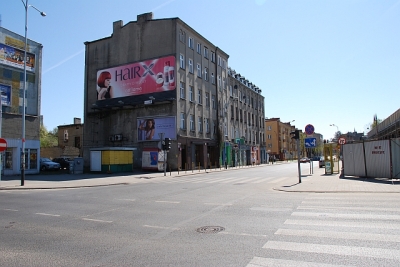According to Oskar Singer, a chronicler of the ghetto, Baluty Market, or Balucki Rynek as it is known in Polish, was the heart and brains of the ghetto.
Balucki Rynek housed the Gettoverwaltung, a branch of the German administration of the ghetto, directed by Hans Biebow. The Jewish administration of the ghetto and its leader, Chaim Mordechaj Rumkowski, who was generally referred to as the Eldest of the Jews, was a subordinate to Biebow.
Rumkowski was appointed to this post in October 1939, even before the ghetto was created, and fulfilled his duties until the end in August 1944. He was an intermediary between the German authorities and the Jews. In the confined district, however, his authority was almost that of a dictator.
The Germans gave Rumkowski carte blanche to organize the ghetto. He created a powerful administrative machinery, consisting of numerous divisions, offices, agencies and labor departments. He appointed a law-enforcement service (the Jewish police), organized a court, public prosecutor's office and prisons. His offices were located at Balucki Rynek in specially built wooden barracks. The Central Secretariat, or the so-called Headquarters through which Rumkowski administered the ghetto, operated from May 1940 until the liquidation of the ghetto. The Central Office of the Labor Departments, which dealt with the organization of production, was also located in that square beginning on October 1, 1940. But above all, Balucki Rynek was the place for loading and unloading food, fuel and raw materials, often supplied to the ghetto through the Radogoszcz (Radegast) train station. Material was also brought in by cart from neighboring villages, and by tram. Readymade goods were leaving the ghetto from here, too.
A special brigade of Jewish law-enforcement officers called the Order Service maintained order when supplies were received or dispatched. A Gestapo post, the political authority of the ghetto, and the 6th District of Schupo, which guarded the ghetto borders and helped police the area, were located nearby, at Limanowskiego and Zgierska streets [see: Schupo and gestapo].
Balucki Rynek was separated from the rest of the ghetto. It could only be entered with a special pass. Important institutions and offices, as well as factories and labor departments, were located around the square, such as a rubber coats factory and the Main Warehouse of the Leather Department at 5 Balucki Rynek. Dworska Street (now called Organizacji WiN Street) housed important departments: the Kitchen Department, the Transport Department, the Dairy Headquarters and the Supplies Department. An open-air coal warehouse, where fuel (coal and wood) was gathered and distributed, was established nearby [see: Dworska Street]. After food, it was the most sought after item in the ghetto.
 One of the most important locations was a tenement building at 25 Lagiewnicka St., opposite the entrance gate to the ghetto, where several district offices operated. There was the High Chamber of Control and the Central Trade Committee, among other administrative bodies. In November 1942, a standard clock with three faces was installed on the roof of that building in order to facilitate the unification of time in the entire ghetto.
One of the most important locations was a tenement building at 25 Lagiewnicka St., opposite the entrance gate to the ghetto, where several district offices operated. There was the High Chamber of Control and the Central Trade Committee, among other administrative bodies. In November 1942, a standard clock with three faces was installed on the roof of that building in order to facilitate the unification of time in the entire ghetto.
Immediately after the war, the barracks at Balucki Rynek were destroyed. Today the area by no means resembles what it looked like during the ghetto years. But fruits and vegetables are sold in the square, as they were in the pre-war era...
On Monday, a conference was held at Balucki Rynek with the participation of the Chairman and representatives of the ghetto court at one side, and representatives of the German authorities on the other. Discussed was the inclusion of issues until now excluded from the responsibilities of the Court of the Eldest of the Jews, i.e. smuggling, illegal currency trade, spreading of information harmful to the German Reich, and homicide committed both in the ghetto and outside of it... The Court would be authorized to inflict all measures of punishment, including the death sentence.
The Chronicle of the Lodz Ghetto, August 4, 1941, Vol. 1, p. 237.
Hans Biebow went mad at Balucki Rynek. He beat up the Chairman so badly that the latter had a hemorrhage. Then he beat Fuksowna the secretary and demolished the office of Jakubowicz, who came in accompanied by Czarnulla, the other member of the Ghetto Board. They were both drunk. They could have simulated intoxication as well, in order to take their revenge on the hated co-manager of the Jewish district.
Jakub Poznanski, A Diary from the Lodz Ghetto, June 17, 1944, p. 167.
On Saturday June 7, the ghetto was visited by Minister Himmler. At Balucki Rynek, in the ghetto management office, Minister Himmler was acquainted with the organization of the local district for the Jews, and later visited one of the tailoring workshops.
The Chronicle of the Lodz Ghetto, June 7-9,1941, Vo1.1,p. 173.

 Home
Home
